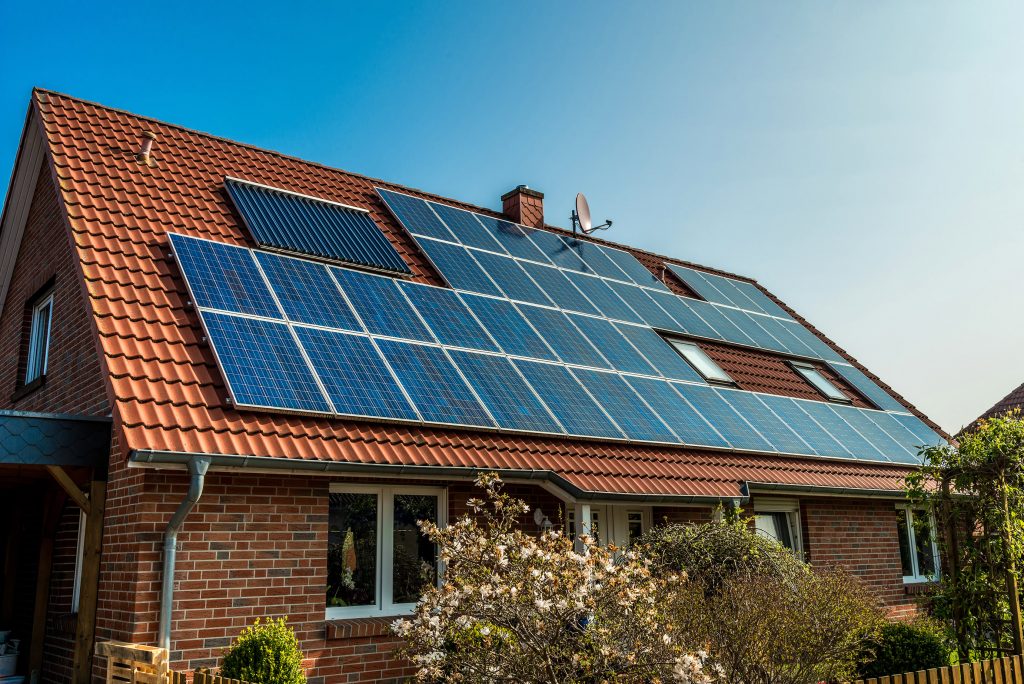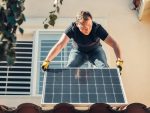Guest post: Is it time to switch to Renewable Energy in your home?
We would all love to do more for the environment. We know that we’re living in precarious times of environmental devastation and global warming that we all play a part in the protection and destruction of the planet. But too many of us think that “going green” is a far off-dream, something only available to those of us willing to relocate to the wild and live like Bear Grylls.
But what if we told you that switching over to renewable energy was not only easy to do, but also cost-effective? In this post, we’ll show you some simple steps you can take to make your home more self-sufficient so that you can save the world and your pennies at the same time.
Power Your Life with Sunshine: Rooftop Solar Panels
Pop quiz: What source of energy has more than four or five billions year’s worth of potential energy to use? Hint: It’s not the standard. scarce fossil fuels that we’ve all been using. Give up? It’s the sun. That shining burning ball of energy in the sky. The sun is not only the source of that enviable summer tan you’ve been nurturing it’s also a great alternative energy source you can use to power your home.
Rooftop solar panels harness the sun’s energy for a renewable and self-sustaining energy source. Fitted onto the roof of your house, solar panels collect sunshine (even on the innumerable overcast days that are typical British fare) and use its solar cells to generate electricity. Any surplus energy is looped back into the main grid so that you’ve got a backlog of energy to power your home through the darker, colder months. And, unlike fossil fuel, the sun’s energy is free. Purchasing and installing solar panels may come at an initial cost, but it won’t be long until you’ll be making some serious savings on your electricity bills.

Harvest the rain: Rainwater Harvesting
Water may be a human right, but too many of us are spending an arm and a leg on our water utility bills. From drinking water to bath time routines and watering our gardens, water is an essential part of our home lives. Did you know that the average person flushes roughly 24 gallons of water down the toilet every day? Each flush adds up and, with it, so too do your water bills. We’re literally flushing cash down the toilet!
Thankfully, there’s a cheaper, more sustainable alternative. Rainwater harvesting can cut your water utility bills by up to 70%, and all you need is a storage tank and filtration system. Rainwater harvesting recycles rainwater to supply water to your home. In the UK, we are no strangers to rainy skies and damp evenings. But now we have a reason to celebrate, rather than bemoan, the weather. When life gives you lemons… turn your rainwater into a cost-effective, self-sustaining, bill-busting water source.
Pump up your heating and cooling systems: Heat Pumps
In the UK, we spend thousands of pounds trying to regulate our house temperatures. Heating gets whacked up in the cold winter months, and fans and AC are rolled in for freakishly hot weather — such as the kind we experienced during this summer’s extended heat wave. But heating systems and air conditioners are not only expensive to run, but they’re also significant players in your carbon footprint. To avoid extortionate bills and do our best for the environment, many of us suffer the changing temperatures — blanket dresses and makeshift igloos, anyone?
There is, however, an alternative to shivering through winter and sweltering through summer — the humble heat pump. Heat pumps are a cost-effective way to decrease your carbon footprint and save on your bills. They work by moving air from the outside of the house into the inside and vice versa for a self-sufficient loop that provides a great alternative to heating and cooling systems. In the winter, heat is pumped from the outside of the home to heat up the inside and, in the summer, it removes the heat from your house and pumps it outside. It’s simple and elegant science that can lower your energy use by a staggering 40%.
Take small steps to make a big difference and call in the professionals
These three ideas are great ways of incorporating renewable energy into your home. But a word of warning is needed. Solar panels, rainwater harvesters and heat pump all require professional installation and maintenance. The market is flooded with these products, so to make sure that you’re getting the best option, always consult a specialist. Trade comparison websites make finding a trustworthy and knowledgeable tradesperson easy, so don’t skimp out. Poorly fitted or positioned solar panels, heat pumps and rainwater harvesters can end up costing you much more money in the long run and are just not worth the headache. Check in with a professional, and the initial investment will have you saving money for years to come.
If you don’t own your home or don’t have the funds to undertake a big project, there’s still plenty you can do. Small changes make a big difference. Why not try switching your standard light bulbs for LED ones? It’s a small step, but LED light bulbs are 25 times more efficient and way more cost-effective, resulting in substantial long-term savings.
Everyone has the potential to go green — it just takes some thoughtful research and careful planning. Save the planet and your pennies by switching to renewable energy today and make the future a little brighter.
Author bio
Patrick Smithworks with HaMuch, a tradespeople comparison website with a difference. HaMuch allows individuals to search for tradespeople in their local area and compare prices.
*Collaborative guest post
![[AD] We went to the newly opened Cha Sha Kingston a couple of weeks ago, and wow — taste bud adventure unlocked! The boys devoured the masala fries and chicken tikka rolls, while we couldn’t get enough of that epic kebab butter curry 😍🍛.
It’s amazing value for food this tasty (and everyone left happy and VERY full!).
Delicious food, vibrant vibes and incredible value — the perfect combo for your next meal.
📍Cha Sha Kingston
43 Surbiton Road, KT1 2HG
🌐 chasha.co.uk
Other Cha Sha locations in Birmingham, Ilford, Southampton and Wembkey
#ChaSha #ChaShaKingston #KingstonEats #FoodieFinds #UKFoodie #FoodReview #KingstonUponThames #FamilyEats #FamilyDining #FoodieKids](https://suburban-mum.com/wp-content/uploads/2016/02/574770541_18560351146016840_6855048070839528040_n-180x320.jpg)

![[AD] We’re a cricket-mad family, so we’re buzzing that @thehundred is back this August! 🏏🔥
To get ready, M tried out the official FREE Activity Pack — and it’s brilliant! 🙌
Packed with fun games, creative challenges and sporty tasks, it’s perfect for getting kids hyped whether you’re at home or on the go.
👉Download yours now (link in bio)
@londonspirit @ovalinvincibles #EveryMomentCounts #TheHundred
#EnglandCricket #CricketFamily #TheHundredCricket #LondonBloggers #Cricket #CricketIsLife #kidsfun](https://suburban-mum.com/wp-content/uploads/2022/11/505472555_18531279601016840_7092520074819907569_n-180x320.jpg)



![[AD - Press visit]
We enjoyed the glorious sunshine this weekend with a trip to Brighton. We went on the @brightoni360official which is right by the sea front.
The i360 pod take a slow journey up, allowing you to take in views across Brighton and the South Downs 450ft above ground. There’s a bar inside with drinks and snacks available to purchase and the experience lasts 25 minutes.
Afterwards, we headed to the open air roller rink for a roller skating session!
The roller rink is:
⭐ Suitable for over 5s
⭐ £6.50 if you have your own skates or £9.50 if you need to hire them
⭐ 45 minutes per session
Full details to visit the i360 + skating
📍 Brighton i360, Lower Kings Road, Brighton BN1 2LN
🚗 Parking nearby (we parked in the Regency Square Car park)
🎟️ Prices start from £25.40 for an adult and £16.90 for a child
🕐 Opening hours are currently Sun-Fri 10.30am-18.30pm and until 19.30pm on Saturdays
☕️ Bar inside the i360, cafe and gift shop
Book tickets here:
https://tickets.brightoni360.co.uk/tickets/?_ga=2.195305772.1869001490.1689671753-1757164059.1689671753/#events?eventid=157](https://suburban-mum.com/wp-content/uploads/2015/04/417980235_313576471048632_3682382982231216432_n.jpg)

![[AD] ***Summer of fun at Barracudas Activity Camps!****
There is plenty for kids to do at @barracudas_activity_day_camps
From Tennis, Archery, Swimming, Motor Sports and more you can be sure that there will be something for kids aged 4.5-14. ⚽🏈🥅🎾🏓🏎️🏹🏊♂️🏉
You can book on a day by day basis - so it can fit in with any other days out/activities you have planned and there are early drop off and late pickup options available. Barracudas are also Ofsted registered so you can use your Childcare Vouchers too.
⭐⭐⭐Get £20 off a week or £4 off a day using my discount code: MARIA20⭐⭐⭐
#BarracudasActivityDayCamp #BarracudasActivityCamp #BarracudaAmbassadors #SummerHolidays #SchoolHolidays #Summer2023 #SummerCamp #DayCare #Camp #KidsCamp #surreymummy #surreymums #SummerOfFun #ActivityCamps #HolidayCamps #Childcare #SchoolHolidays #schoolholidaycamps](https://suburban-mum.com/wp-content/uploads/2024/07/353583570_625625966167953_545896259645102575_n.jpg)



![[AD] We have some super exciting news...we have been chosen to be Laser Quest Ambassadors, and the boys are over the moon!
We are really lucky that our local Laser Quest (@laserquestkingston) is just around the corner from us. It means we can pop in of a weekend or anytime during the school holidays, and with summer just around the corner, I know Laser Quest will be one of our go-to places for some family fun.
As well as games of Laser Quest, there are also VR experiences and arcade amusements too. To find out a bit more about how Laser Quest works, you can read my blog post: https://www.suburban-mum.com/laser-quest-kingston/ (clickable link in bio)
Don't forget to keep an eye out for our Laser Quest posts - I'm going to be giving away two family passes to use at Laserquest Kingston!
If you can't wait and want to head down to Laser Quest to try it out, use the code SUMMER30 for 30% off your booking. The code is valid from now until the end of August 2023 and can be used on Laser Quest games and birthday party bookings.
#LaserquestAmbassador #Laserquest #LaserquestKingston #ActivitiesForKids #FamilyFun #DaysOutWithKids #Lasertag #LaserquestVR #Kingston #ThingsToDoInKingston #SurreyFamilyDaysOut #ThingsToDoWithKids #RainyDayFun #SurreyMummy #SurreyLife #LifeWithKids #LifeWithBoys #familyfunday](https://suburban-mum.com/wp-content/uploads/2015/04/353230107_797358078406942_2405522556733455165_n.jpg)

![[AD] The sun has finally made an appearance and the boys have been making the most of it by spending it
in the garden.
They’re go-to is always football and they’ve been trying to improve their aim and accuracy with the new Messi Foldable Footlball goal from the #MessiTrainingSystem range.
I love the fact the goal is foldable, making it easy to store away when not in use. It is also lightweight so you can effortlessly pack it up and take it to the park or to a friend’s house.
The Messi Foldable Football Goal retails at £36 and can be purchased from @argos
You can read my full review here: https://www.suburban-mum.com/messi-foldable-football-goal/
#TrainLikeMessi #FoldableFootballGoal #FootballSkills #OutdoorFun #LionelMessi #LeoMessi #FootballAtHome #OutdoorKids #JustGetOutside #OutdoorsAndFree #ScreenFreeKids #WhateverTheWeatherKids @flair_gp](https://suburban-mum.com/wp-content/uploads/2015/04/341194882_615024710178056_41977149395989448_n.jpg)

![[AD] We are absolutely thrilled to announce that we are Barracuda Ambassadors again this year.
With Easter just around the corner, the boys were sent the @barracudas_activity_day_camps new camp kit in preparation for the school holidays.
There’s a wide range of activities for kids aged 4.5 - 14 including Tennis, Archery, Basketball, Arts & Crafts and more.
If you like the sound of Barracudas, find out more over on their website. You can also save £20 a week or £4 a day, using my discount code: MARIA20](https://suburban-mum.com/wp-content/uploads/2024/07/336812306_765234558514317_685553691647241974_n.jpg)


![[AD - Gifted]
Last weekend we were invited to try out @tsarettaspice’s new Bottomless Brunch menu and I can tell you it was thumbs up all round!
There’s a good choice tapas on offer from Punjabi fish fingers, Indo Chinese Chicken to Spiced Lamb Scotch Eggs and Manchurian Cauliflower (which was amazing!)
If you’re local to Twickenham and fancy giving them a try here’s are the details.
Tsaretta Spice Bottomless Brunch
⭐️£37.50 per head for bottomless Prosecco or cocktail of the day
⭐️£55 per head for bottomless Champagne
⭐️ Food included: 4 tapas selections and dessert or 2 tapas selections, a pav or naanwich and dessert
⭐️ Non-alcohol brunch is also available
Tsaretta Spice
55 Church Street
Twickenham
TW1 3NR
You can also read our full review over on the blog (link in bio)](https://suburban-mum.com/wp-content/uploads/2024/07/334565436_5960402314015030_663031098700829518_n.jpg)



